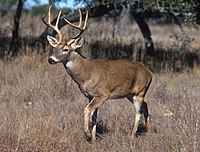
Photo from wikipedia
Habitat availability can affect important life-history traits such as survival; however, little information exists on how microhabitat characteristics found at parturition sites selected by dams and bed sites selected by… Click to show full abstract
Habitat availability can affect important life-history traits such as survival; however, little information exists on how microhabitat characteristics found at parturition sites selected by dams and bed sites selected by their offspring differ from the surrounding area and from each other. Therefore, we assessed how vegetation affected maternal parturition and offspring bed site selection for white-tailed deer (Odocoileus virginianus) in the Northern Great Plains. Dams selected for sites with decreased vegetation height, potentially improving their visibility, which may increase their ability to escape approaching predators. Conversely, there was no variation between vegetative characteristics at neonate bed sites and their associated random sites, indicating grasslands provide adequate concealment for neonates. Dams possess the ability to flee from approaching predators, thus increasing the importance of visibility while giving birth. Conversely, neonates depend on fear bradycardia as their main antipredator defense, so concealment is more important. Our results suggest that vegetation structure is an important characteristic to white-tailed deer as habitat needs vary between adults and neonates.
Journal Title: Mammal Research
Year Published: 2020
Link to full text (if available)
Share on Social Media: Sign Up to like & get
recommendations!